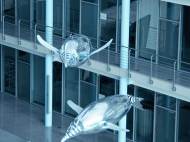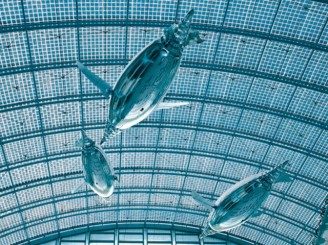AirPenguin – flying robot penguins, what’s next?
 Folks from German company Festo keep creating bionic marine animals which float in air. Penguins are fascinating creatures which have lost their ability to fly in the course of their genetic development as marine birds, but Festo engineers managed to create an artificial penguin and taught it “autonomous flight in the sea of air”. Named AirPenguin, the robot is used to showcase Festo equipment and engineering.
Folks from German company Festo keep creating bionic marine animals which float in air. Penguins are fascinating creatures which have lost their ability to fly in the course of their genetic development as marine birds, but Festo engineers managed to create an artificial penguin and taught it “autonomous flight in the sea of air”. Named AirPenguin, the robot is used to showcase Festo equipment and engineering.
Despite it is 3.7 meters long the AirPenguin is an agile and maneuverable autonomous flying object. It comprises a helium filled balloon, which has a capacity of approximately 1 cubic meter and thus generates around 1kg of buoyant force. At each end of the balloon is a pyramid-shaped flexible structure of four carbon fiber rods, which are connected at joints by a series of rings spaced 10cm apart. The rings together with the carbon fiber rods yield a 3D Fin Ray structure that can be freely moved in any spatial direction.
Each pair of spatially opposed carbon fiber rods is connected via Bowden cables and a double pulley, and can be extended and retracted in contrary motion by an actuator. By superimposing two perpendicular planes of rotation, any desired spatial orientation can be realized.
A strut to which the two wings are attached passes through the helium-filled balloon. This new type of wing design can produce either forward or reverse thrust. Each wing is controlled by two actuators: a flapping actuator for the up-and-down movement of the wings, and a further unit that displaces the wing strut to alter the pressure point of the wings. There is also a central rotational actuator for the two flapping wings that direct their thrust upwards or downwards, thus making the AirPenguins rise or descend.
The wing strut, which is supported at the pivot point of the torso, can be moved either towards the front or rear edge of the wing. Displacing the strut towards the front, for example, causes the wing’s pressure point to migrate forwards. The air-stream pressure bends the cross-section of the wing in such a way as to produce a profile that generates forward thrust. If the wing strut is moved towards the rear edge of the wing, the pressure point is likewise moved to the rear and the AirPenguin flies backwards. With this design a self-regulating, wing pressure-controlled, passively twisting adaptive wing has been realized for the first time.
The AirPenguins are also equipped with complex navigation and communication facilities that allow them to explore the space they float in on their own initiative, either autonomously or in accordance with fixed rules.
By means of XBee, based on ZigBee, large volumes of data can be transmitted between the penguins and the transmitting stations by 2.4-GHz band radio. The penguins recognize each other on the basis of their distances to the transmitting stations. The rapid, precise control allows the AirPenguins to fly in a group without colliding, while also mastering height control and positional stability. As an alternative, they can act synchronously as a group. A comprehensive central surveillance system provides security in case of sensor failure. When AirPenguins are on low energy supply it prompts the penguins to return to the charging station.
The ongoing development of sensor and control technology is thus also being promoted along the road to decentralized, autonomously self-controlling and self-organizing systems thanks to the inspiration from nature.










Leave your response!